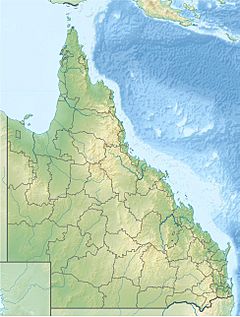Balonne River facts for kids
Quick facts for kids Balonne |
|
|---|---|

The Balonne River at St George, Queensland
|
|
|
Location of where the Balonne River branches to form the Bokhara and Narran rivers in Queensland
|
|
| Country | Australia |
| State | Queensland |
| Region | South West Queensland |
| City | St George |
| Physical characteristics | |
| Main source | Condamine River at Surat 274 m (899 ft) |
| River mouth |
near Dirranbandi 171 m (561 ft) 28°43′27″S 148°03′6″E / 28.72417°S 148.05167°E |
| Length | 479 km (298 mi) |
| Basin features | |
| River system | Darling River, Murray-Darling basin |
| Tributaries |
|
| Reservoir | Lake Kajarabie |
The Balonne River is an important river in South West Queensland, Australia. It is part of the huge Murray-Darling Basin river system, which is one of the largest river systems in the world. The Balonne River helps bring water to many areas inland.
Contents
The Balonne River: A Lifeline in Queensland
The Balonne River is actually a continuation of the Condamine River. It starts flowing after the Condamine River passes through a town called Surat. From there, the Balonne River travels south-west.
Where Does the River Flow?
As the river flows, it passes through the E.J. Beardmore Dam, which creates a large water storage area called Lake Kajarabie. It then continues through the town of St George. About 20 kilometers (12 miles) north of Dirranbandi, the river splits into two main parts.
- The western part becomes known as the Culgoa River.
- The eastern part continues as the Balonne River.
After flowing through Dirranbandi, the Balonne River splits again! This time, it forms the Bokhara River to the west and the Narran River to the east. The Narran River eventually flows into the important Narran Wetlands. The Bokhara River later joins with the Barwon River.
The Culgoa River (which was the western branch of the Balonne) and the Barwon River (which includes the Bokhara) eventually meet up. When they join, they form the beginning of the famous Darling River. This shows how all these rivers are connected!
The area that collects water for the Balonne-Condamine river system is very large, covering about 136,014 square kilometers (52,515 square miles). This area includes many important wetlands, which are special places where water covers the land, helping many plants and animals.
The longest rivers and creeks that flow into the Balonne River are:
- The Condamine River
- The Maranoa River
- Dogwood Creek
- Yuleba Creek
- Tartulla Creek
In St George, the Andrew Nixon Bridge crosses the Balonne River. This bridge carries the Balonne Highway, which is an important road for the region.
Storing Water for the Land
To help manage the water, several structures have been built along the Balonne River and its tributaries.
- E.J. Beardmore Dam: This dam was built in 1972 where the Maranoa and Balonne Rivers meet. When it's full, the water backs up for 70 kilometers (43 miles) along the Balonne River, creating a large reservoir called Lake Kajarabie.
- Jack Taylor Weir: Downstream from the Beardmore Dam, this weir (a small dam) was built in 1953.
- Gill Weir: On Dogwood Creek, one of the Balonne's tributaries, there's another weir called the Gill Weir. It can hold a lot of water, about 1,050 megalitres (277 million US gallons).
These dams and weirs are important for storing water. This water is then used for things like irrigation, which helps farmers grow crops like cotton in the area.
A River with an Ancient Name
The first European explorer to cross the Balonne River was Major Thomas Mitchell. He crossed it on April 23, 1846, which was St George's Day. Mitchell decided to name the river "Balonne." He chose this name because it came from the Mandandanji people's word for water or running stream, which was balun, balonn, or balonne. This shows the river's long history and connection to the Aboriginal people of the area.
Images for kids
-
Irrigation channel for cotton fed from E.J. Beardmore Dam.
-
Siphon irrigation of cotton near St George, Queensland.
-
Jack Taylor Weir viewed from downstream side at St George, Queensland.






